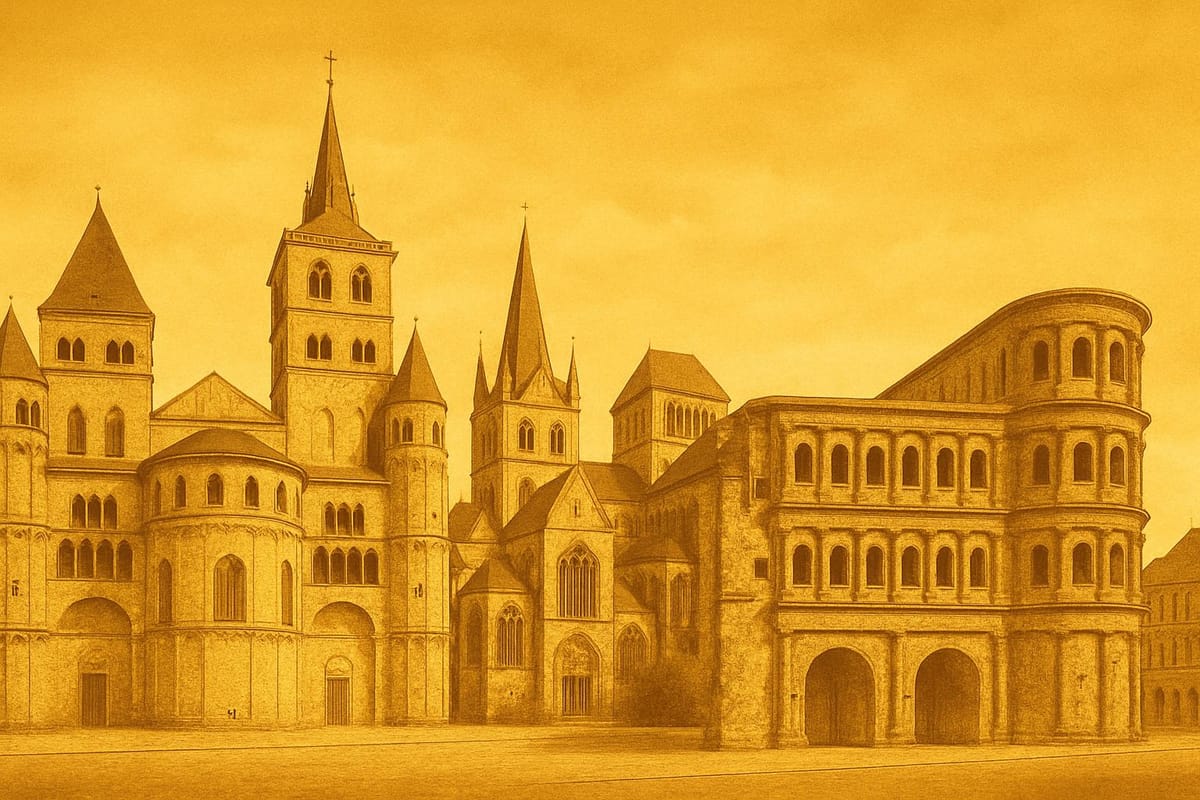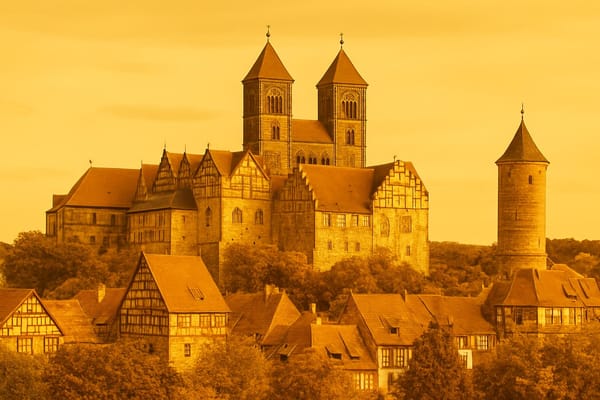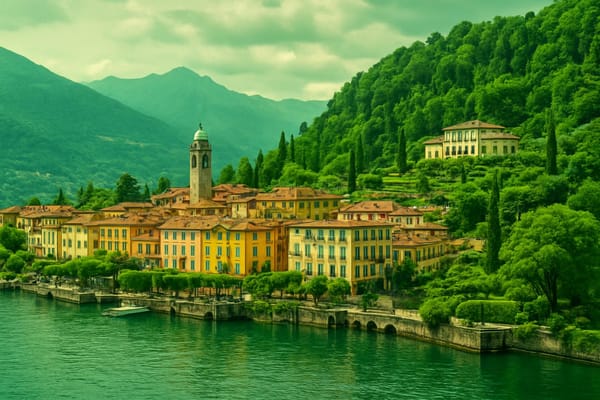Trier
Explore ancient Roman ruins, UNESCO cathedral, cobblestone streets & Moselle wine tours.

Important things to know about Trier
Trier, a compact and characterful city in Germany, sits in the state of Rhineland-Palatinate and unfolds along the gentle curves of the Moselle River, offering a blend of urban life and regional charm; its streets reflect a layered history that shapes local identity, while contemporary Trier balances a vibrant university scene, small-business commerce, and a resilient service economy that supports both residents and a steady flow of visitors without relying on a single industry. The city’s rhythm is marked by seasonal markets, lively cafés, and a strong tradition of wine production in the surrounding hills, which influences local gastronomy and community events; this connection to viticulture gives Trier a distinct culinary palette and supports a network of family-run vineyards and specialty food producers. Urban planning in Trier emphasizes walkability, public transit links to regional hubs, and the coexistence of green corridors with compact neighborhoods, making everyday life convenient and environmentally conscious. Cultural institutions, educational programs, and active civic organizations contribute to a dynamic social fabric where student energy, artisan craft, and long-standing family ties coexist. Festivals and neighborhood gatherings punctuate the calendar, fostering a sense of belonging and continuity. With a temperate climate, an emphasis on sustainable mobility, and a reputation for blending tradition with modern amenities, Trier stands out as a German city that combines heritage, community, and quality of life in a distinctly regional context.
Sightseeing hot-spots in Trier
Trier, Germany, is a treasure for lovers of history and architecture, where every corner seems to whisper ancient stories. The city’s most iconic sight, the Porta Nigra, towers above the streets as a dramatic reminder of Rome’s northern reach, and nearby the Roman Bridge spans the gentle Moselle River with stonework that has endured for centuries. As a designated UNESCO World Heritage site, Trier’s ensemble of Roman monuments draws visitors eager to walk the same paths as emperors, and the compact historic center makes sightseeing easy on foot.
Beyond the gates and bridges, Trier offers remarkable religious and imperial architecture: the imposing Trier Cathedral (Dom) and the elegant Church of Our Lady showcase a blend of Romanesque and Gothic styles, while the vast brick hall of the Aula Palatina (Basilica of Constantine) evokes the scale of imperial power. The remains of the Imperial Baths (Kaiserthermen) and the atmospheric Roman Amphitheatre reveal everyday life in antiquity, and for those curious about more recent history, Karl Marx’s birthplace invites reflection on ideas that shaped modern times. Museums around the city help put these sites into context, making Trier a rich destination for cultural sightseeing.
To make the most of a visit, stroll the riverbanks, sample Moselle wines at a cozy tavern, and let the city’s festivals and markets add local color to your itinerary. Whether searching for “things to see in Trier” or planning a focused historical tour, the city delivers an unforgettable mix of ancient ruins, sacred spaces, and lively contemporary culture that promises satisfying sightseeing for history buffs, wine lovers, and casual travelers alike.
Hotels to enjoy in Trier
Trier is a compact, history-soaked city where choosing the right hotels in Trier can transform a sightseeing trip into a memorable escape. Whether you're searching for luxury accommodations with riverside views of the Moselle, a boutique hideaway in the pedestrianized city center, or budget-friendly rooms close to the famous Porta Nigra, Trier hotels offer a spectrum of styles and services. The rich Roman heritage-highlighted by the Roman Baths and UNESCO-listed monuments-makes proximity to historic sites a top consideration, and many properties pair modern comforts with classic décor to reflect the city’s character. Business travelers find practical options near conference facilities and transport hubs, while couples and families often prioritize breakfast service, free parking, and easy access to museums and riverside promenades.
When planning your stay, compare amenities such as free Wi-Fi, on-site dining, and family suites to match your travel needs; reviews and photographs will help you gauge the ambiance and cleanliness of each property. Choosing hotels in Trier close to public transit allows efficient day trips to the surrounding wine country and nearby Luxembourg. For an authentic experience, look for accommodations that promote local gastronomy or partner with wineries along the Moselle valley. Seasonal events and market days can affect availability, so booking early is recommended to secure the best rates and room types. Thoughtful selection of a Trier hotel ensures convenient access to landmarks, comfortable nights after long days of exploration, and the chance to immerse yourself in the unique blend of Roman history, medieval charm, and modern hospitality that defines this German gem.
Restaurants to try in Trier
Trier's dining scene is a delightful fusion of historic charm and contemporary flavor, making it one of the most appealing destinations for food lovers in the Rhineland-Palatinate region. Strolling from the Porta Nigra to the bustling Hauptmarkt, visitors discover a wide range of restaurants in Trier that showcase everything from hearty traditional German cuisine to inventive international menus and modern bistro fare. The city's proximity to the Moselle valley means many eateries feature excellent local Moselle wine pairings alongside seasonal dishes prepared with fresh regional produce. Whether searching for cozy taverns, refined dining rooms, or lively wine bars, those researching Trier restaurants will find ample options that blend authentic ambiance with professional service and excellent value.
For anyone optimizing travel plans or a weekend getaway, the diversity among restaurants in Trier caters to families, couples, and solo travelers alike, offering memorable meals near Roman ruins and riverside promenades. The culinary landscape is characterized by chefs who respect local traditions while embracing contemporary techniques, which makes the city a recommended stop for gastronomy-focused visitors exploring western Germany. From midday lunch specials to leisurely multi-course dinners, the range of tastes and atmospheres helps Trier stand out among regional destinations; online searches for “best restaurants Trier” frequently highlight this balance of history, wine culture, and innovative cuisine that keeps both locals and tourists returning.
Best shopping stops in Trier
Trier is a delightful destination for shopping enthusiasts, where Roman history and modern retail blend seamlessly. As you wander from the imposing Porta Nigra through the historic center, the pedestrianized streets reveal a mix of high-street brands, independent local boutiques, and charming specialty shops that make shopping in Trier a memorable experience. The bustling Hauptmarkt and adjacent lanes are full of fashion stores, artisan studios, and antique dealers offering unique finds you won’t see elsewhere. Shopping near famous landmarks creates a distinctive atmosphere: you can pause between purchases to admire ancient architecture or enjoy a coffee at a cozy café, making Trier Germany not only a cultural stop but a genuine retail destination.
Beyond fashion, Trier’s shopping highlights include excellent gourmet and specialty food shops where Moselle wine and the region’s celebrated Riesling are prominently featured, perfect for gift-buying or tasting on the spot. Seasonal events such as the festive Christmas market and lively local markets add extra variety, showcasing handcrafted goods, regional delicacies, and street-food favorites. Whether you are hunting for designer labels, one-of-a-kind souvenirs, or culinary treats, the city’s compact layout makes exploring easy and rewarding. Embrace the mix of history, hospitality, and retail energy-Trier offers a rich shopping experience that complements its cultural treasures and invites visitors to discover something special around every corner.
Nightlife highlights in Trier
Trier, Germany offers a vibrant nightlife that blends ancient charm with modern energy. As evening falls, the cobblestone streets around the Porta Nigra and the cathedral fill with locals and visitors drawn to cozy wine bars, lively student bars, and elegant cocktail lounges. The city's location along the Moselle River means many venues have scenic outdoor terraces where you can sip outstanding Riesling while watching boats pass. From intimate craft beer pubs to chic bars playing contemporary tunes, there is an atmosphere for every mood-romantic, relaxed, or ready to dance. The mix of students from Trier University and history-loving tourists creates a friendly, cosmopolitan crowd that keeps the night interesting.
For those seeking music and dancing, Trier nightlife includes clubs with local DJs, venues hosting live music nights, and cultural events that spill into late hours, especially on weekends and during festivals. Nighttime walks past illuminated Roman monuments make the city feel cinematic before or after a bar hop, and late-night cafés offer a calm alternative for conversations. Practical options like taxis and late buses help you move between hotspots, while many places emphasize safety and a welcoming vibe. Whether you want a quiet glass of wine by the Moselle or an energetic club experience, Trier’s night scene delivers memorable evenings in a uniquely historical setting.
Getting around in Trier
Trier’s airport and train situation is shaped by its historic location on the Moselle and strong cross‑border links rather than by a local international airport: the city itself lacks a major commercial Trier airport, so travelers typically use nearby hubs such as Luxembourg Airport (convenient for many residents and visitors), with further options in Saarbrücken, Frankfurt or Cologne for wider international connections; ground access from these airports is well served by a combination of regional rail and long‑distance coach services. Rail travel centers on Trier Hauptbahnhof, which offers frequent regional trains and connections toward Koblenz, Saarbrücken and Luxembourg, making it easy to reach high‑speed rail corridors and national long‑distance services via transfers; travel times to neighboring regional centers are generally in the 40–60 minute range, and cross‑border commuting to Luxembourg is a daily reality for many. Local and regional public transport includes a dense city bus network, regional buses and services from providers like FlixBus, plus park‑and‑ride options that link the suburbs to the station, so whether you search for “Trier train station”, “public transport Trier” or practical ways to reach nearby airports, the combination of rail, bus and nearby international airports ensures flexible access for tourists and commuters alike.
Culture must-see's in Trier
Trier is a city where Roman heritage and vibrant modern life meet along the banks of the Moselle. Strolling through the historic center, visitors encounter the imposing Porta Nigra, the ancient Roman amphitheater, and the soaring spires of the Trier Cathedral (Dom)-all pillars of the city's UNESCO World Heritage status that tell a story of more than two millennia. The cultural scene in Trier, Germany extends beyond monuments: intimate museums such as the Rheinisches Landesmuseum and the Karl Marx House offer deep dives into archaeology, art, and social history, while contemporary galleries and theaters keep the arts scene lively. The interplay of Roman ruins with Romanesque architecture and modern exhibitions creates a layered experience that appeals to history lovers, art enthusiasts, and families alike.
Local culture in Trier is also shaped by lively traditions, wine culture from the surrounding Moselle vineyards, and a calendar full of seasonal events that bring streets and squares to life. Culinary offerings combine hearty regional dishes with international flavors, often enjoyed in atmospheric courtyards beneath medieval facades. Throughout the year, concerts, open-air performances, and cultural festivals showcase both classical music and contemporary acts, making Trier a year-round destination for cultural tourism. For those searching for authentic Trier attractions and rich cultural experiences in Germany, the city’s combination of archaeological wonders, museums, and everyday conviviality makes it an unforgettable stop on any itinerary.
History of Trier
Trier's long and layered past begins in antiquity, when the city known to the Romans as Augusta Treverorum emerged as one of the most important urban centers north of the Alps. Founded in the late 1st century BCE and flourishing through the Roman Imperial era, Trier became a political and economic hub on the Moselle river, linked by roads and rivers to the wider Empire. Its surviving Roman monuments - most famously the Porta Nigra, the imposing city gate that still dominates the skyline - testify to a period of monumental construction that included baths, an amphitheatre, and elaborate palaces. The city played a crucial role in the later Roman Empire, especially during the rule of Emperor Constantine, and archaeological finds such as mosaics, inscriptions, and the remnants of public infrastructure continue to attract scholars and visitors. The density and preservation of these ancient structures led to international recognition; many of Trier’s Roman-era sites are now part of the UNESCO World Heritage inscription, underscoring the city’s significance for understanding Roman urbanism in northern Europe.
Through the Middle Ages, Trier retained prominence as an ecclesiastical center, with the Trier Cathedral (St. Peter's) and a powerful archbishopric shaping politics, art, and pilgrimage across the region. The city’s medieval and early modern history is marked by its role within the Electorate of Trier, shifting allegiances in the complex tapestry of the Holy Roman Empire, and later periods of French control during the Revolutionary and Napoleonic wars followed by incorporation into Prussian territories. Industrialization and modern urban development in the 19th and 20th centuries brought new economic forces, while the surrounding vineyards strengthened Trier’s long-standing association with wine and river commerce. Today, Trier is a dynamic blend of ancient and modern life: its archaeological sites, baroque churches, museums, and vibrant cultural festivals draw tourists while local conservation and research projects work to preserve and interpret the city’s layered heritage. This continuity from Roman foundations through medieval ecclesiastical power to contemporary cultural and touristic appeal makes Trier a compelling subject for anyone exploring the history of Germany, European urban development, or heritage tourism.



